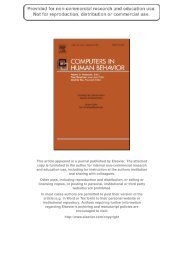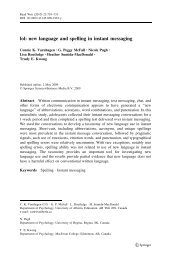Six Models for the Internet + Politics
Create successful ePaper yourself
Turn your PDF publications into a flip-book with our unique Google optimized e-Paper software.
38 <strong>Six</strong> <strong>Models</strong> <strong>for</strong> <strong>the</strong> <strong>Internet</strong> + <strong>Politics</strong><br />
had posed. Later on, <strong>the</strong> Office of Science and Technology Policy implemented<br />
a series of tools <strong>for</strong> on-line input into <strong>the</strong> open government policy. In <strong>the</strong> United<br />
States, however, such tools are not “empowered” in that <strong>the</strong>y do not grant to<br />
users actual decision-making power—<strong>the</strong>y are consultative tools. Ra<strong>the</strong>r, ICTs are<br />
most often used <strong>for</strong> e-government purposes—opening up and optimizing access<br />
to public in<strong>for</strong>mation, and improving <strong>the</strong> speed and quality of governmental service<br />
provision (Shkabatur 2011). While <strong>the</strong>se improvements are clearly positive<br />
and laudable, <strong>the</strong>y do not <strong>for</strong>ce public officials to share <strong>the</strong>ir decision-making<br />
power with <strong>the</strong>ir constituents.<br />
Sometimes, however, politicians and policy makers do possess a more participatory-democratic<br />
orientation. In some of those cases, <strong>the</strong> use of digital technologies<br />
to create additional avenues of direct engagement can be very powerful.<br />
Beginning in <strong>the</strong> late 1980s, <strong>the</strong> practice of participatory budgeting has spread<br />
to many cities throughout Brazil and o<strong>the</strong>r countries in Latin America (Wampler<br />
and Avritzer 2005; Baiocchi, Heller and Silva 2011). To supplement face-to-face<br />
practices of participation, <strong>the</strong> Brazilian city of Belo Horizonte initiated an e-participatory<br />
budgeting program in 2006. Citizens who participated in <strong>the</strong> e-participatory<br />
budget plat<strong>for</strong>m could discuss, vote <strong>for</strong>, and collectively allocate $11<br />
million USD equivalent to <strong>the</strong> city-wide public works projects that <strong>the</strong>y judged to<br />
be most important. In that year, 172,938 people cast electronic votes. That figure<br />
amounts to a stunningly high 9.98 percent of <strong>the</strong> city’s electorate (Peixoto<br />
2008). One of <strong>the</strong> authors of this article has found that a number of German cities<br />
have created empowered ICT plat<strong>for</strong>ms, but that no US government has conferred<br />
actual decision-making power to participants in an electronic venue<br />
(Shkabatur 2011). The German Pirate Party offers ano<strong>the</strong>r illuminating example<br />
of <strong>the</strong> potential of e-participation. The party was started by a group of <strong>Internet</strong><br />
activists as an online campaign against intrusive copyright legislation in Europe<br />
and later took shape as a more consolidated political unit. Running on an<br />
agenda of <strong>Internet</strong> freedom and full transparency, <strong>the</strong> party participated in German<br />
elections and won seats in local governments and state parliaments in <strong>the</strong><br />
country. The party relies on <strong>the</strong> software program Liquid Feedback to virtually suggest<br />
debate and vote on policy proposals in real time (Kron 2012). Although<br />
electronic participatory budgeting and <strong>the</strong> German Pirate Party show that ICT<br />
can indeed create direct connections of voice and influence between citizens<br />
and politicians, <strong>the</strong>y are currently exceptions that prove our rule against such<br />
connections.<br />
Digital communication can amplify direct engagement between citizens and<br />
<strong>the</strong>ir governments in policy making. In order <strong>for</strong> it to do so, however, politicians<br />
and policy makers must want to engage directly with <strong>the</strong>ir citizens. This is sometimes,<br />
but seldom, <strong>the</strong> case.<br />
Truth-Based Advocacy (Model 4)<br />
In a fourth model that we call “truth-based advocacy,” ICT plat<strong>for</strong>ms are<br />
mechanisms by which organized advocacy groups bring salient, often surprising,<br />
facts to light in credible ways that tilt public opinion. These plat<strong>for</strong>ms<br />
amplify <strong>the</strong> impact of truth in a way which in<strong>for</strong>ms and buttresses activism<br />
both through traditional means, such as voting, and nontraditional means<br />
such as online campaigns and social media outlets. As <strong>the</strong>se new and important<br />
truths are acknowledged in <strong>the</strong> public sphere, <strong>the</strong>y exert pressures that<br />
change <strong>the</strong> actions of politicians and o<strong>the</strong>r policy makers, resulting in new<br />
policies and public actions. The most recent high publicity example of truthbased<br />
advocacy is Wikileaks. Figure 5 below depicts truth-based advocacy<br />
schematically.
















